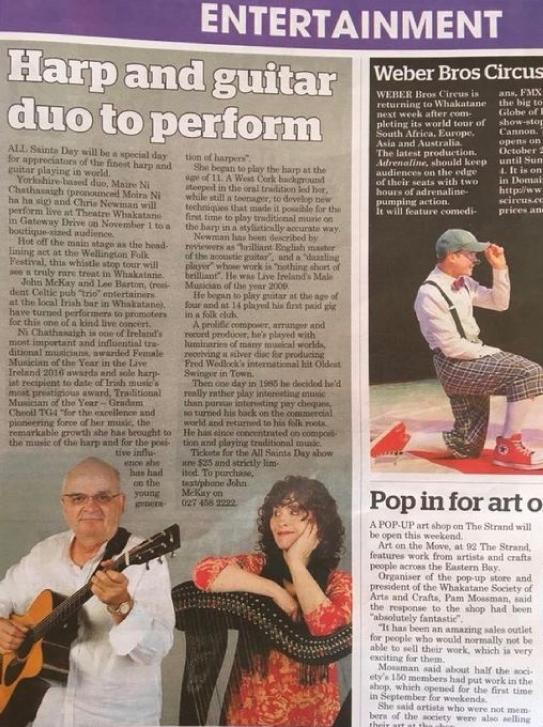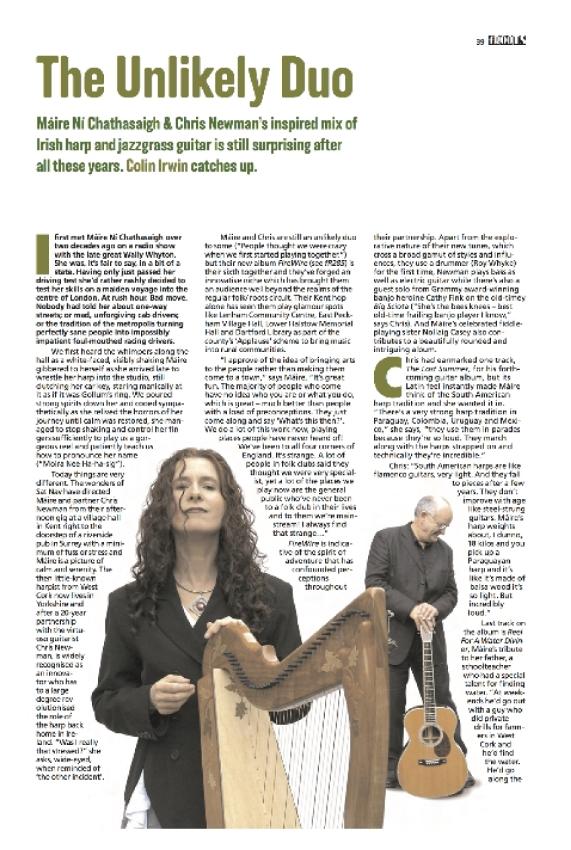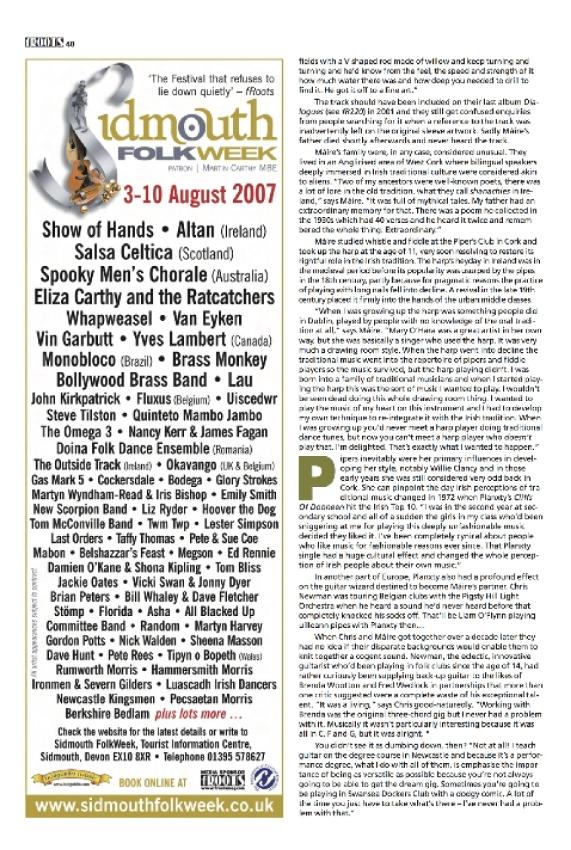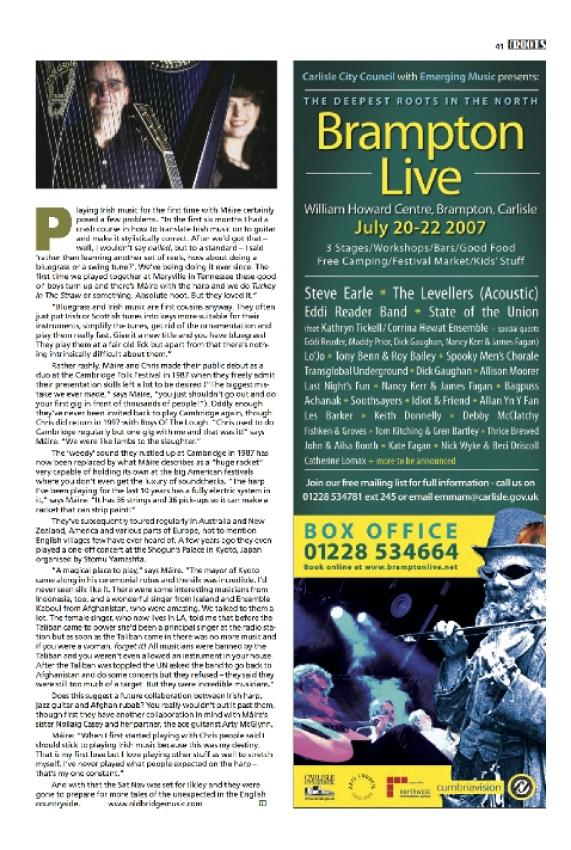|
|
||
 |
||||
TG4 Irish Traditional Musician of the Year 2001 |
||||
|
Interview with Máire published in the Observer-Dispatch, Utica, NY, 23 March, 2023 Interview with Máire published in The Echo 4 September, 2022 Interview with Máire published in The Irish News 22 July, 2022 Interview with Chris & Máire (cover feature) published in April / May 2021 issue of The Living Tradition magazine Interview with Máire in Cork's Evening Echo, 15 February, 2017 Here's a link to an interview with Máire in The Herald Scotland on 8 April, 2015, prior to her Edinburgh Harp Festival performance with Chris. You can also find copies of press features about Máire and interviews with her over the years, which we're posting gradually as we get around to clearing out old boxes of memorabilia and scanning the contents. |
||
|
||||||||||||||||||
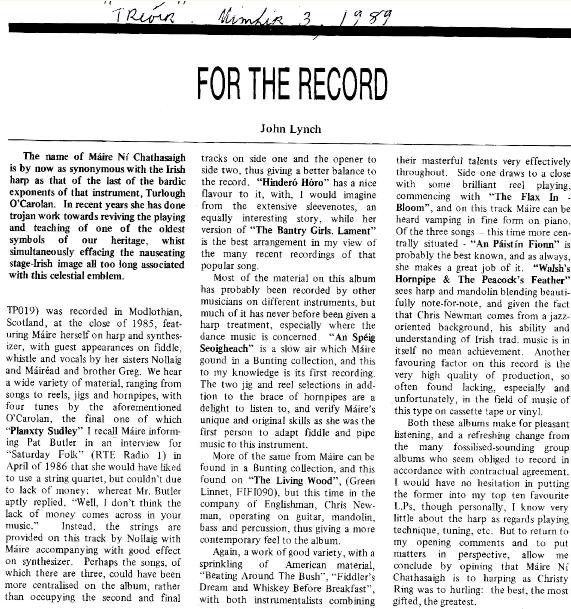
Being called “Virtuosic, fascinating, dramatic, original, inspired, gloriously adventurous, dazzling, brilliant, stunning, impassioned, electrifying, bewitching, moving, achingly beautiful, influential, revered, unique...” by well-respected media such as The Times, The Daily Telegraph, The Guardian, The Irish Times, The Scotsman, and Folk Roots, or “the most interesting and original player of the Irish harp today” by the late Derek Bell—Northern Irish harpist virtuoso—should already speak enough of a musician. Máire Ni Chathasaigh is certainly one of Ireland’s most influential harpers of our time.
Born 1956 in Cork City, Ireland, Máire was familiar with and interested in music since a very young age. She started from playing the piano at the age of six, the violin when she was ten, and finally the harp at the age of eleven. And having a self-conviction as a full-time professional harper in times like now—instead of any other ‘popular’ instrument—has certainly made her a true artist. She also has earned recognitions such as won a first prize in All-Ireland and Pan-Celtic Harp Competitions on a number of occasions, and received Irish music's most prestigious award, that of Traditional Musician of the Year - Gradam Cheoil TG4 - "for the excellence and pioneering force of her music, the remarkable growth she has brought to the music of the harp and for the positive influence she has had on the young generation of harpers” in 2001.
Now once again, we are proudly pleased to present you this interview session with one remarkable musician, yet a very humble woman.
LTTW: First of all, we’d like to know a bit of your background. At what age did you get interested in (playing) music? And at what age do you decide that music is your thing?
Máire: I can’t remember a time when I wasn’t interested in music. My mother tells me that I could sing before I could walk! I’ve therefore been singing since I was tiny. I started to play the piano when I was six, the violin when I was ten and the harp when I was eleven.
When at school, I was interested in everything and studied as wide a range of subjects as I possibly could. I was very fortunate that the school facilitated this, as Irish schools these days would be far too concerned with the accumulation of the maximum number of points towards university entrance to allow me to get such a broad exposure to so many diverse disciplines. I was accepted into the Medical School in University College Cork, but changed my mind on the day of registration when I realised that medical studies would leave very little time for playing music! I decided upon Celtic Studies – the study of Irish, Welsh and early Irish history – instead. After completion of a post-graduate teaching diploma, I embarked on a music degree, but after one year of this my parents “suggested” that I might like to get a job! I taught in a second-level school for three years, during which time I became convinced that the creative life was for me not a choice but a necessity. I therefore resigned from what was a very well-paid position and embarked on the insecure but rewarding career of a professional musician.
Where did you have your musical training?
I was fortunate to grow up playing both traditional Irish music and classical music in parallel – it has been a great advantage in life to have the ability both to learn by ear and to sight-read. My earliest musical training was provided by my mother. Traditional music education was provided within the family and through membership of the Cork Pipers’ Club. Classical music education on piano was provided by a private teacher, followed by teaching in the Cork Municipal School of Music. Good harp teaching was very hard to find outside of Dublin at that time, so I had to make do with rudimentary teaching from a lady who taught singing to harp accompaniment. I wanted to be able to play traditional Irish dance music on the harp – tunes that I had been playing on the tin whistle and fiddle – so during my teens I developed the special techniques necessary to perform it in an authentic-sounding style, which I still use to this day. I didn’t get “proper” harp tuition until I was 21, when a wonderful pedal harpist called Denise Kelly came to Cork to teach at the SchoolMusic. The great grounding which she gave me in classical harping enabled me to refine and polish my approach to the traditional music I really wanted to play of.
OK, now in the subject of Celtic music; Celtic music is found in many areas across Europe, from Spain, France, England, Wales, Scotland to Ireland. What is the common denominator(s) among them, and what are the unique features of each?
Linguistically, the Celtic languages can be divided into two branches: P-Celtic and Q-Celtic. The languages currently spoken in Ireland and the Highlands of Scotland, and in the past in the Isle of Man, belong to the Q-Celtic branch and are closely related. Welsh, Cornish and Breton belong to the P-Celtic branch and are closely related. Though there would be no mutual comprehension between the speakers of Irish and Welsh, for example, the languages when examined are similar in grammar and syntax. The civilisation of medieval Wales was however similar to that of Ireland in social organisation, literature, myth and legend and in the primacy of the harp in musical expression.
Irish and Scottish musical traditions are closely related, but are very different to Welsh, Cornish and Breton musical traditions – certainly in the form in which they’ve survived into modern times. There are no obvious common denominators.
So, strictly speaking, one can speak of Pan-Celtic language, culture, civilisation, art – but not of a Pan-Celtic musical language.
In the music market, Celtic is one of the most well-known among the world’s roots music with Latin and African as perhaps the main “competitors”. How do you think Celtic music reaches that level in the world?
Even though “Celtic” is not a good or accurate label artistically or historically, as a commercial construct it has been inspired! It’s the best marketing wheeze ever thought up by a record company.
What does Celtic music means to its people? And what does it mean to you personally?
I can only talk about Irish music, which is immensely important to Irish people and intimately bound up with our sense of self. It is hugely important to me personally and is the conduit through which I choose to express myself artistically.
What kind of influence and/or contribution do you think that Celtic music has given to the world of music?
It has a special aesthetic that even in diluted form sparks the imagination of so many people. Musical languages, like languages, encapsulate and represent the spirit of a people and the greater the number of them that flourish, the more they enrich us all. It’s fascinating to see how our particular musical language has moved from a peripheral and endangered position to a prominent one. I’m sure practitioners of currently obscure forms of music will be heartened by this and will be emboldened to introduce themselves to the wider musical world…
There are quite a few women in Celtic music, but only a handful playing the Celtic Harp that includes you of course. Why is that? What made you decide to take on the harp?
My mother tells me that I’d always wanted to play the harp (though I have no recollection of this), so therefore they bought me one when the opportunity arose. I was eleven at the time.
There are now lots of female harpers in Ireland, but only a handful who play professionally.
How different is the Celtic harp compare to other harps, physically? Does it require specific playing techniques as well?
There isn’t really such a thing as a Celtic Harp, historically speaking. A very specific type of harp – usually referred to as the Ancient Irish Harp - was played in Ireland and Scotland for over a thousand years, until the beginning of the nineteenth century. It had several unique features: its forepillar had a pronounced curve and was T-shaped in section; its soundbox was hollowed out of one piece of solid willow attached to a soundboard; it was strung with brass and played with long nails; it was held on the left shoulder; the melody was played with the left hand and the accompaniment with the right; since it was very reverberant, the harpers used very complex stopping techniques to shape phrases. At the beginning of the nineteenth century, this harp was replaced by what is often called the Neo-Irish Harp. This looked superficially like the old Irish harp in that it had a curved forepillar, but it was constructed in a modern manner and played with the pads of the fingers and is the harp, with the addition of modern refinements, that we still play today. It is the harp people normally mean when they refer to the Celtic Harp.
The Welsh harp, by contrast, was always physically very different, and still is so today, though it too was played on the left shoulder.
The Irish/Scottish harp in itself does not require specific performance techniques. However, the stylistically correct performance of Irish dance music does require the use of specific techniques. The techniques I developed for this purpose in the 1970s – there had hitherto been no tradition of dance music performance on the Irish harp - have since then been widely adopted and adapted.
Music in general has transformed into a subject that is merely treated as entertaining and income generating activity. Its other roles and functions, along with its ritual side, continue to disappear. Does this happen to Celtic music as well? Shall musicians and societies accept this change as the future way of looking at music?
Traditional Irish music’s “other roles and functions, along with its ritual side” do seem to be “continuing to disappear”. A number of older musicians in Ireland feel despondent about this change, which from their point of view dates from the creation of the “Celtic Music” marketing brand and the subsumation of Irish music into that. I am much more optimistic, however. I know from personal experience that it is possible to be a professional musician (i.e., “entertain and generate income”) and be true to oneself artistically. It’s unfortunately the case that many musicians for whom commercial success is of over-riding importance do abandon any ambition to touch the heart – with the result that music which is heavily hyped and expensively marketed tends so often to lack soul. But I have a lot of faith in people’s capacity to be moved by music and am constantly amazed by it. Music is the most abstract of all art forms, while at the same time being the most emotionally transfixing. I know that certain 17th century Irish harp airs have the capacity to pierce the heart of the most unpromising audience. Such moments can’t be faked or forced and are what make performance so endlessly rewarding.
We must never accept the commodification of music. As artists we must make common cause with and draw strength from others with the same ethic and world view - and remember that the environmental movement was once considered to be hopelessly romantic and impractical!
Fame and fortune also seem to replace passion as the instrument in measuring the “success” of an artist. How do you reply to this matter?
To me, passion is all-important.
How do the young in UK perceives and (un)appreciates Celtic music?
The young in England are generally speaking uninterested in Celtic music. Large numbers of older people like it very much, I’m happy to say, as our concerts in England are usually very well-attended! They are however perhaps not so emotionally attached to it, as England is not a Celtic country. A good percentage of the young in Celtic countries like Scotland and Ireland are very interested and engaged with the music.
Roots music such as Celtic is very much associated with acoustic instruments. Do the growing use of electric instruments and digitalization affect the acoustic features of Celtic music?
I don’t think that the use of electric instruments in any way affects the essence of the music. The equating of “acoustic” with “authentic” is to me a complete red herring. I myself use an electro-acoustic Camac harp in my duo performances with Chris – the harp sounds the same as it does acoustically, only louder! An instrument is just a vehicle which conveys musical thought and feeling and the fetishisation of its acoustic properties by those I dub “acoustic fundamentalists” is to me simply wrong-headed, and largely to miss the point of music…
You have travelled distances to perform, and have had many chances in getting acquainted with music of other cultures. Are there any of them that inspire or impress you more than the others? And why?
Even the most cheerful Irish music often has a melancholy undertow: I love this duality of mood in music, so am naturally attracted to other music which shares these characteristics – Swedish, Old-Time American, Eastern European, Middle- and Far-Eastern… Traditional African music has a gentle, limpid quality that is immensely attractive.
Who influence and/or inspire you the most, and why them?
So many things inspire me – not just music, but poetry, art… I’ve always been drawn to the music of Bach: so intricate and perfectly balanced. In terms of traditional music, I’ve always loved the singing of Máire Áine Nic Dhonncha (d.1991) and the piping of Willie Clancy (d. 1973): their music is endlessly subtle and creative.
Did you have a dream(s) that you have lived it? Anymore is yet you would like to live in?
I have many dreams!
It’s great that you still remember Sacred Ryhthm Festival at the Nijo Castle in Kyoto. Would you join again if Sacred Bridge Foundation organized another cultural event?
Absolutely! We would love to take part in another such cultural event! Our trip to Kyoto was extraordinarily memorable, from so many different points of view…
Any messages you would like to say to the audience?
Trust your instincts. Don’t allow marketing men to convince you that black is white: beauty in music is life-enhancing and its absence saps the spirit.
…And any words of wisdom for Listen To The World?
No words of wisdom, I’m afraid! I will simply say that I love Listen to the World’s ethos and its ambition to present the real, the true and the beautiful in music.
(The above interview is accessible at http://www.listentotheworld.net/interviews/maire-ni-chathasaigh-harps-desire/
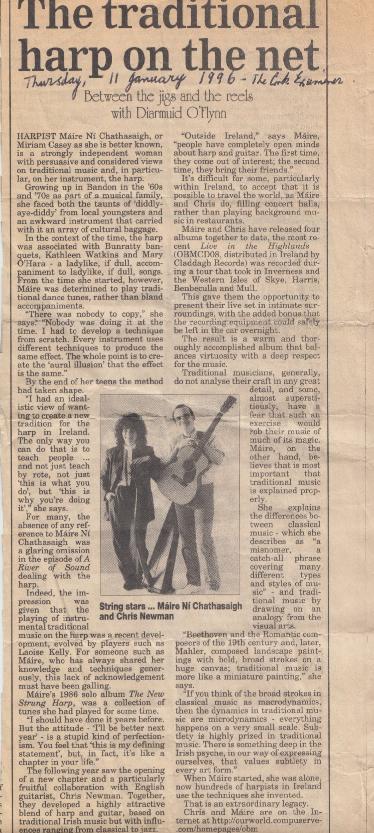
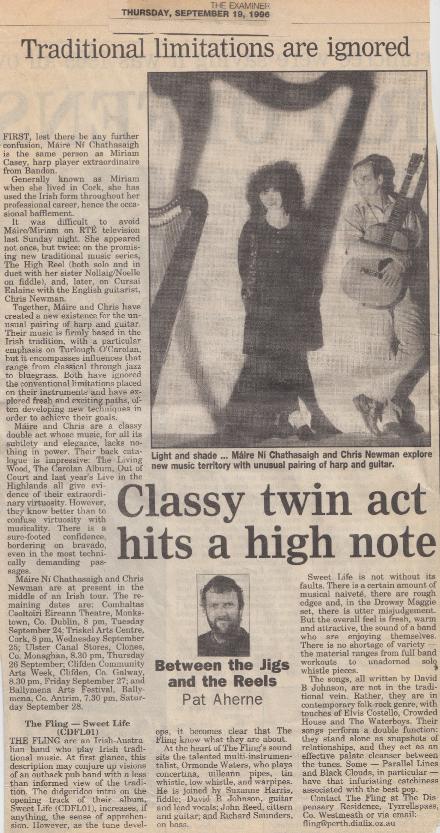
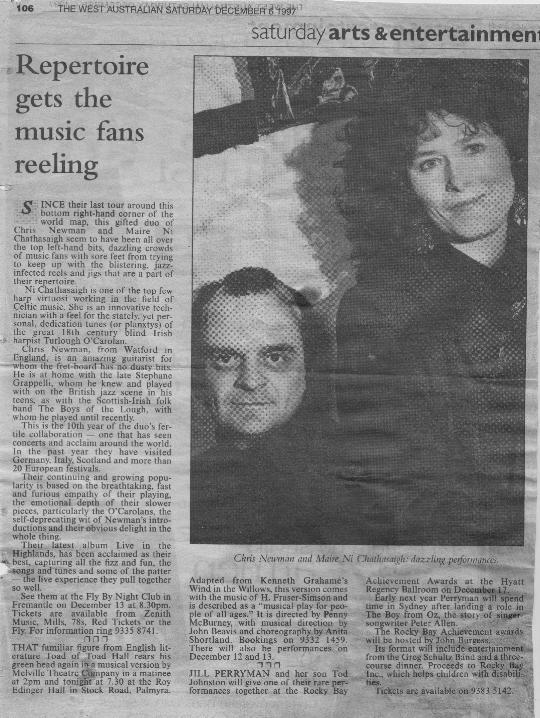
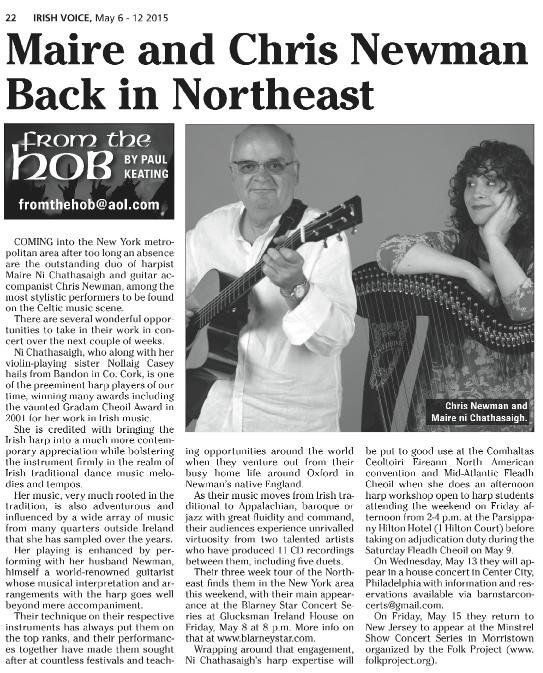
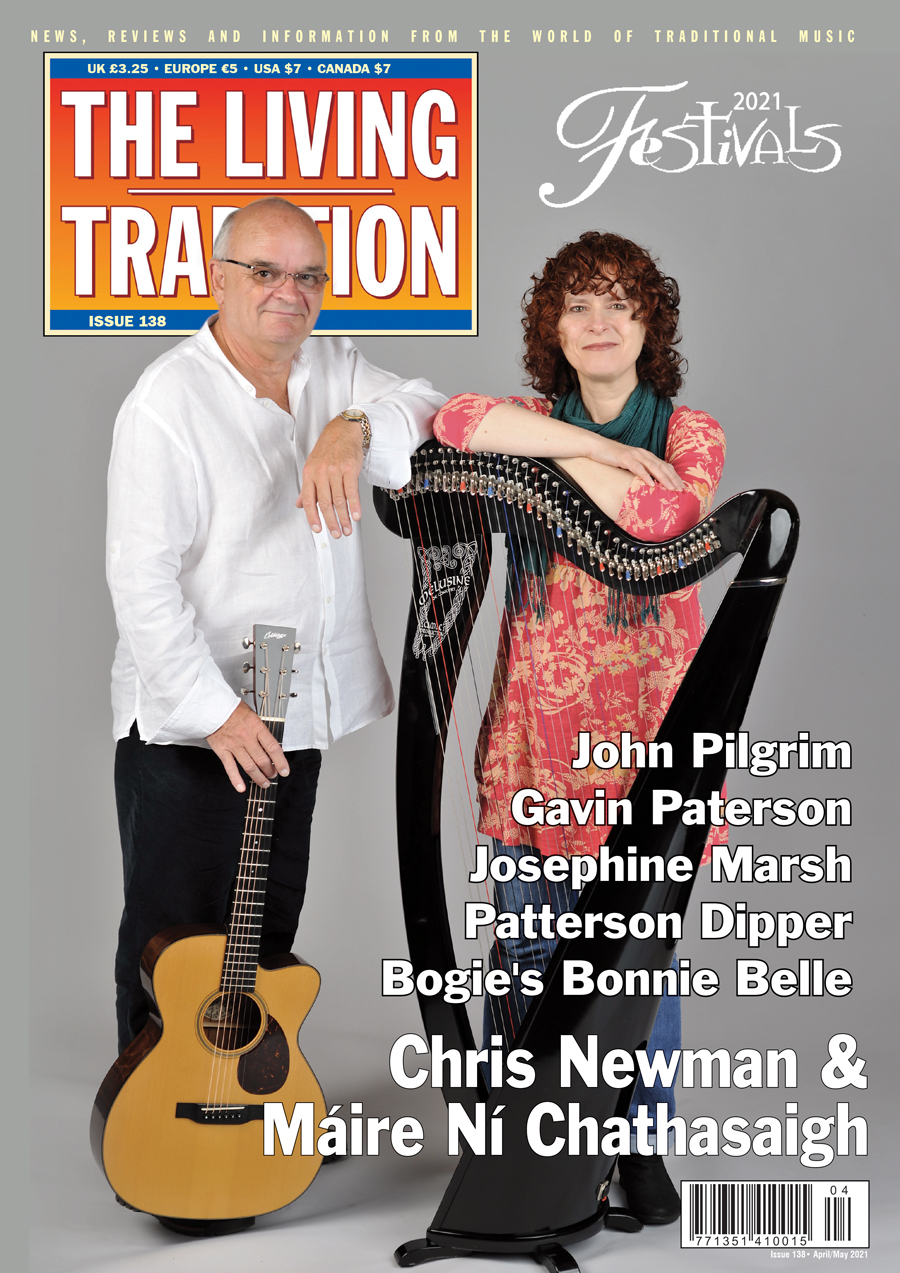
Máire and Chris on the front cover of the April / May 2021 issue of The Living Tradition.
More covers below, here and here...
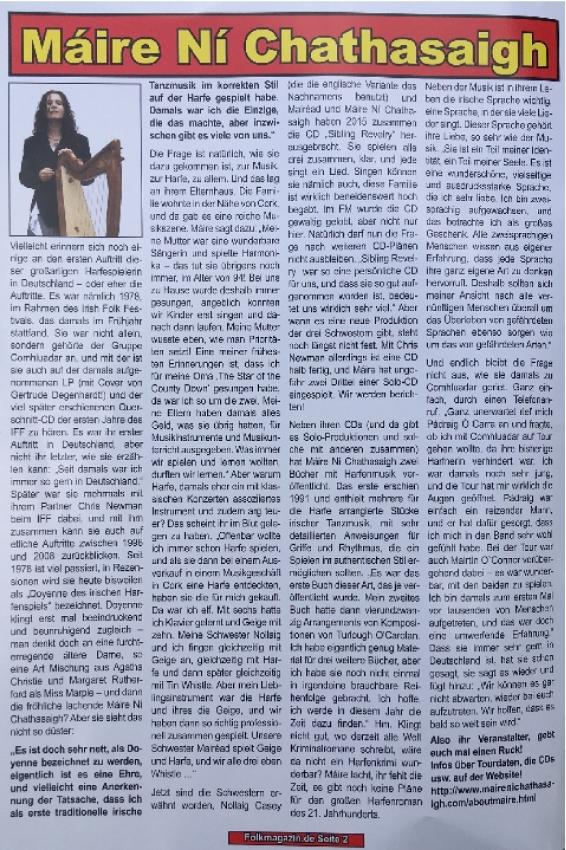

The front cover of the June-July 2017 issue of Folk Magazin (Germany), featuring a photo of Máire!
More covers above, here and here...

The front cover of Comhaltas Ceoltóirí Éireann's magazine Treoir, featuring a photo of Máire
